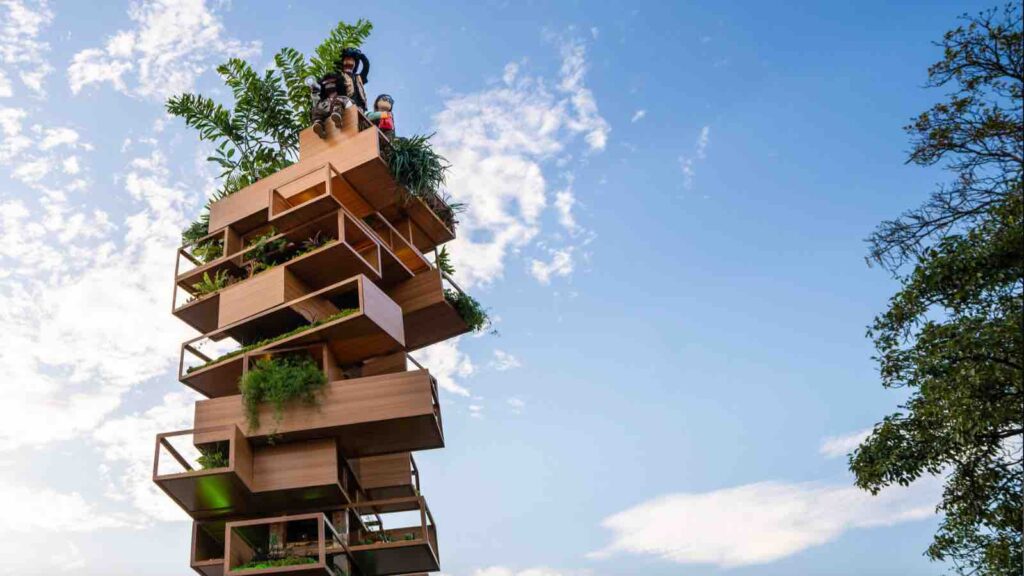The Biodiversity Jenga is sponsored by Chris Larsen and nonprofit SeaTrees, features 33 stacked blocks, each representing one of Colombia’s unique ecosystems.
CALI, COLOMBIA — Delegates and global leaders at the COP16 Biodiversity Conference in Cali were met with an arresting sight: a towering 21-foot-tall structure balancing precariously at the heart of the conference’s Blue Zone. This striking installation, aptly named Biodiversity Jenga, is the work of internationally renowned artist and environmental advocate Benjamin Von Wong. With its towering presence and symbolic instability, the installation is a stark visual metaphor for the urgent need to protect 30% of the world’s land and water by 2030.
RELEVANT SUSTAINABLE GOALS



A Tower Built on Fragile Foundations
The art piece, sponsored by Chris Larsen and nonprofit SeaTrees, features 33 stacked blocks, each representing one of Colombia’s unique ecosystems. Landscape artist Milton Duarte designed these blocks to showcase environments as varied as kelp forests, coral reefs, and seagrass meadows, along with key terrestrial ecosystems like the Amazon rainforest and Andean cloud forests.
More than 150 intricately handcrafted animal sculptures populate these ecosystems, created by over 200 students from Cali’s Luis Madina and Santa Librada schools. At the peak of the installation, three children’s sculptures—designed by local artist Raizha Guzmán—carry symbolic items: binoculars to observe, a megaphone to advocate, and a watering can to nurture. The message is clear: humanity’s future rests in how we choose to engage with and protect nature.
Scattered around the base of the tower are blocks that have been deliberately removed. Each of these blocks contains a diorama crafted by artist Sasha Herrera, depicting the main forces destabilizing ecosystems—such as pollution, monoculture farming, urban sprawl, deforestation, and plastic waste. By extracting these blocks from the tower, the installation symbolizes the fragility of our ecosystems and the precarious balance that human activities continually threaten.
A Spotlight on Marine Ecosystems: SeaTrees Biodiversity Credits
More than just a visual statement, Biodiversity Jenga also introduces a groundbreaking solution to biodiversity loss: SeaTrees Biodiversity Credits. These marine biodiversity credits, unveiled during COP16, fund the restoration of critical ecosystems like mangroves, kelp forests, and coral reefs. This initiative, developed by the nonprofit SeaTrees, aims to redirect much-needed conservation resources to marine ecosystems, which play an essential role in climate regulation and coastal protection.
“Marine ecosystems receive a fraction of conservation funding,” says Michael Stewart, SeaTrees co-founder. “With these biodiversity credits, we can change that and direct resources where they are most urgently needed.” The credits, called SeaTrees Biodiversity Blocks, aim to enhance coastal resilience and reverse the decline of critical habitats, thereby tackling biodiversity loss while contributing to carbon sequestration.
“Marine ecosystems receive a fraction of conservation funding,” says Michael Stewart, SeaTrees co-founder. “With these biodiversity credits, we can change that and direct resources where they are most urgently needed.” The credits, called SeaTrees Biodiversity Blocks, aim to enhance coastal resilience and reverse the decline of critical habitats, thereby tackling biodiversity loss while contributing to carbon sequestration.
The People Behind the Project: Collaboration at Its Core
This ambitious project was no solo effort. It brought together a diverse team of artists, engineers, and environmental experts coordinated by Charlotte de Casabianca, the Colombia chapter lead of Burners Without Borders. The collaboration received vital support from Colombia’s Ministry of Environment (Minambiente), the Secretary of Culture from the Gobernación del Valle, eco-tourism group Cultour, and design collective La Linterna.
The tower’s complex structure was fabricated by Jonny Edmonds and his team at Metamateriales SAS, who faced the challenge of building a modular yet resilient installation. What appears precarious is in fact engineered to withstand the elements, reflecting the need for innovative solutions in the face of environmental uncertainty.
After the conference, the installation will find a permanent home at Cali’s Botanical Garden, serving as an enduring symbol of our collective responsibility to protect and restore ecosystems for future generations. As the installation stands tall and yet fragile, it carries a clear message: the fate of the planet hangs in a delicate balance, and we must act decisively to prevent the collapse.
Learn more about the project: www.biodiversitygame.org
Watch the video about how we built the art: www.biodiversityjenga.com
Watch the video about how we built the art: www.biodiversityjenga.com
Lead image courtesy of Von Wong Productions
You may also be interested in :
Towering ‘Carbon Phoenix’ in Thailand Turns Climate Concern Into Art




